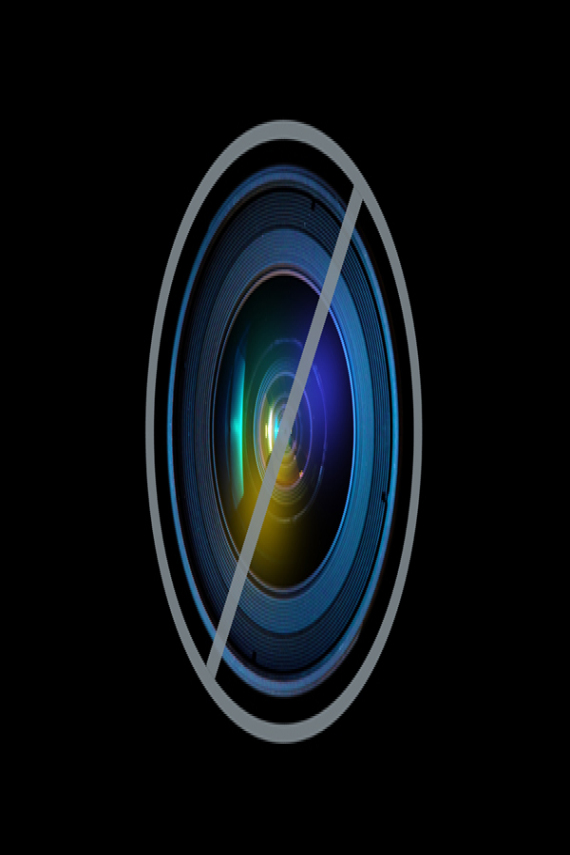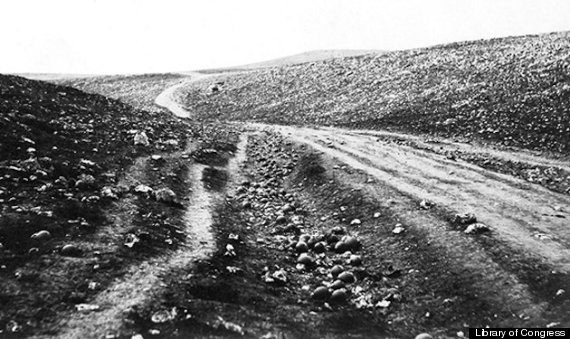Talk about making history.
Filmmaker Errol Morris believes a famous early war photo is a fake, according to Radiolab, and that the cameraman doctored it the old-fashioned way: by moving the scenery with his bare hands.
That would explain the cannonballs strewn on the road in Roger Fenton's Crimean War shot, "Valley of the Shadow of Death." Once celebrated as one of the first battle-scene photographs, it might be the first fraud, Morris asserts.
Roger Fenton's Crimean War photo (below) with cannonballs on the road, fires blanks in terms of authenticity, one expert says. Scroll down to compare it with the alleged original without cannonballs. Not quite the same impact, huh?
"Shadow of Death" is nothing more than a staged improvement on another photo Fenton took at the same site from the same angle, Morris explained to Radiolab recently. The second photo showed no cannonballs on the road. Morris said he is convinced the latter is the original and that the British photographer rolled the cannonballs onto the road to create a more emotionally-charged scene.
"You imagine this fusillade of artillery fire raining down on this landscape," Morris said on the show.
The Crimean War (1853-56) pitted the Russians against the British, French, Ottoman Turkish, and Sardinia-Piedmont, according to Encyclopedia Britannica. Both sides lost around 250,000, with Fenton capturing some of the tragedy on film.
But documentary maker Morris ('The Fog of War") called Fenton "a coward" on Radiolab and asked, "Who the hell knows what Fenton was thinking?"
Morris, also the author of "Believing Is Seeing" (Penguin), didn't question the authenticity of a dead man's work without exhaustive research. Inspired by author Susan Sontag's earlier claim that "Shadow of Death" was manipulated, Morris has obsessed over the supposed doctoring for years. He once wrote extensively about it for the New York Times.
According to several reports, Morris interviewed five historians. Two believed the photo was the staged second shot. Two thought it was the real deal and that soldiers later removed the cannonballs to use them again. And one expert kept going back and forth. Then Morris visited the photo site in Ukraine's Crimea to reconstruct the circumstance and gather any evidence he could. Nothing conclusive.
Finally, he met optical engineer Dennis Purcell at a party. The two flipped between the two photos until the answer hit them: a few distinct pebbles on the left side of the road seemed to relocate in the two photographs, as though they had been kicked or pushed inadvertently. Pebbles would travel a bit downhill when struck, so the two concluded that the photo with the rocks further downhill was the second photo -- the posed one with cannonballs on the road. The rocks probably tumbled at the feet of Fenton and his assistants as they shifted the cannonballs, Morris and Purcell said on Radiolab.
"It seems very likely, if not absolutely certain, that Fenton threw a few cannonballs onto the road in order to make a better picture," Slate wrote in 2007.
The ongoing debate brings to mind Joe Rosenthal's iconic War War II photo, "Raising the Flag on Iwo Jima." The picture was stamped as a fraud at one time until it became clear that the flag was indeed raised twice that day. However, neither raising was staged, according to Photopreneur.com.
Now history's dark room has produced another battlefield controversy, more than a century-and-a-half after the images were captured. But is it case closed? "Yeah," Morris told Radiolab.
The alleged original:

